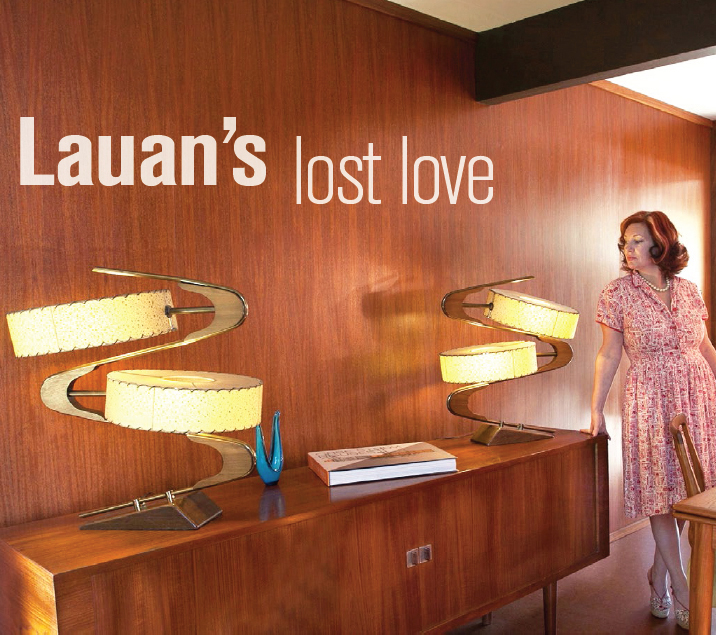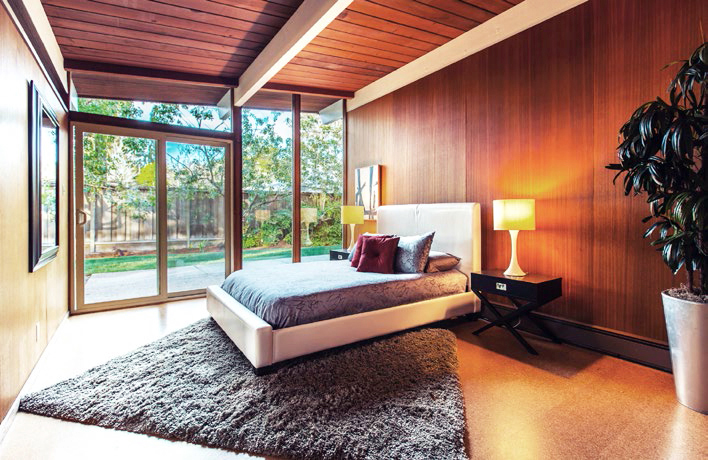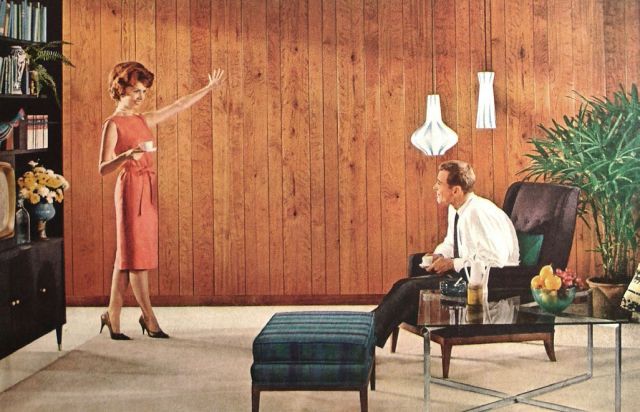
Have Plywood Panels Lost their Allure?
 |
|
|
Are we living in an age of bland? One might think so, after flipping through page after page, or website after website, showing mid-century modern homes for sale. The shape is still there, the walls of glass too. But the walls that were once sheathed in warm, rich plywood today glow white.
Or is brighter always better?
In the new fall '16 issue of CA-Modern magazine we delve into the question: why do people keep painting or sheet-rocking over their original mahogany panels? It's the question that ftames our article ‘Lauan’s lost love.’
Really, the article is a bit of a cri de couer.
We ask: Could it be that Joe Eichler and his architects got this one wrong?
The sheets of interior Philippine mahogany plywood that Eichler so carefully sourced and used to sheath wall after wall in his living and dining areas, hallways, and even bedrooms and kitchens -- was it the right stuff?
Many people today simply think the walls are too dark.
Not everyone, of course. In the same fall issue is an article profiling the Eichler neighborhood of Morepark in San Jose’s Rose Glen area, where many of the owners there treasure the original look, and the warmth and texture, provided by mahogany plywood panels.
 |
|
|
And far be it for us to insist that every mahogany panel needs to stay in place – or be replaced if it has already been removed, whitewashed, or sheet-rocked over. And sure, there are functional considerations – including fire safety.
Why do many Eichler owners replace their paneling? “One main reason people remove and replace them is fire safety,” says Ron Key, owner of Keycon Construction and Design, who has been working on Eichlers since the 1970s. He notes that the thin wood, covered with an oil-based finish, ignites quickly.
“And over the years people have hung pictures on the wall,” Key says. “You get this different tonal quality based on the sun’s contact with the panels, and it’s impossible to get rid of that.”
“You can’t sand it down. The veneer is extremely thin. You’d sand through it.”
But a decision to replace panels is also a matter of taste. Sheetrock can be installed behind panels for fire safety. And, Key says, there are solutions for damaged panels that preserve the original look.
It is important, especially for new Eichler owners, to think before they paint. Look at the lauan [as the panels were originally called], understand their function in the home.
 |
|
|
What was it about this paneling that caused Joe Eichler to use it in all of his homes? He even used it in the Summit, the all-concrete high rise where he himself lived, with wife Liliane, in the penthouse. The penthouse too was sheathed in mahogany.
Eichler loved wood paneling for the same reasons many of his fellow builders and contemporary architects did. It added warmth to modern designs that could otherwise come across as cold, or at least as coolly detached.
It evoked the Arts and Crafts era and Asian residential architecture. And wood was much loved by the man seen almost as a mentor both by Eichler and by his architects, Anshen and Allen—Frank Lloyd Wright.
Wright’s mastery of texture through the use of wood, brick, concrete, stone, and glass influenced a whole generation of modern architects during the mid-century.
And plywood, though it had roots going back millennia, was really something of a new material right after World War II, and was seen as exciting – and affordable.
“Plywood really did not gain wide acceptance as a building material until the hard usage requirement of World War II demanded intrinsic improvement in this product that eventually raised its acceptance to unprecedented heights,” one author noted.
 |
|
|
Impossible to get during the war, by 1949 Philippine mahogany was back on the market. “Mahogany supply good, says Philippine official,” was the September 14, 1949 headline in the Los Angeles Times.
Soon Philippine mahogany – it actually came from several Southern Asia countries, including Malaysia and Indonesia – was flooding the American market, often sold in sheets four by eight feet in dimensions.
Baylaun Philippine Mahogany advertised that it came “from tropical Basilan Island…in the Sulu Sea,” with wood “beautiful and exotic – yet moderate in cost!”
Eichler himself was so meticulous about the quality of the paneling in his homes, he bought it not off the shelf, but from a Japanese firm that milled it to Eichler Homes’ specifications.
Few if any other builders were using anywhere near the quantity of high-quality plywood mahogany paneling that Eichler was employing from the 1950s through the early 1970s.
As Eichler’s longtime construction foreman Bill Willis once said, “Joe Eichler really loved that wood paneling.”
To read more about the lure and lore of mahogany plywood paneling, read ‘Lauan’s lost love,’ our sneak preview of the new fall issue of CA-Modern magazine.
- ‹ previous
- 295 of 677
- next ›



